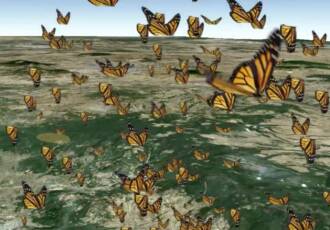
Butterflies are one of the most beautiful and amazing creatures of nature. They attract attention with their varied colors, graceful flight and intricate patterns on the wings. However, in addition to their aesthetic value, butterflies play an important role in scientific research.
Butterflies are the object of study in various fields of science, including evolutionary biology, ecology, genetics, and animal behavior. Their diversity and characteristics allow scientists to study many aspects of life on Earth. For example, butterflies can be used to study the processes of evolution and adaptation to changing environmental conditions.
An important aspect of research involving butterflies is their role in ecosystems. Butterflies are pollinators of many plants, which contributes to their reproduction and the conservation of biodiversity. Also, butterflies are food for many types of predators, which affects food chains and interactions in ecosystems.
Research related to butterflies is of practical importance. For example, the study of butterflies can help determine the state of the environment and identify changes caused by human impact. Also, on the basis of research on butterflies, it is possible to develop methods for controlling pests of agricultural crops and find new sources of biologically active substances.
The role of butterflies in scientific research
Butterflies play an important role in scientific research due to their unique biology and behavior. They are the object of study for many disciplines, including entomology, ecology, genetics, and evolutionary biology.
1. Ecosystem indicators
Due to their sensitivity to environmental changes, butterflies can serve as ecosystem indicators. The study of their populations and diversity allows you to learn about the state of the environment and the impact of anthropogenic factors on natural ecosystems. For example, a decrease in the number of a particular species of butterfly may indicate air pollution or habitat loss.
2. Model organisms for research

Butterflies are also popular model organisms for research in various fields of science. Their short life cycle and simple genetics make it easy for scientists to study various aspects of their biology, including morphology, behavior, reproduction, and genetic variation.
3. Study of the mechanisms of evolution
Due to their diversity and adaptability, butterflies provide scientists with a unique opportunity to study the mechanisms of evolution. Research in the field of genetics and evolutionary biology of butterflies allows us to understand how changes in the genome occur and how they affect adaptation to various environmental conditions.
In general, butterflies are important objects of research that help to expand our knowledge of biodiversity, ecology, and evolution. Their role in scientific research is invaluable and continues to be relevant in many areas of science.
Biodiversity and its study
Biodiversity, also known as biodiversity, is a measure of the diversity of life on Earth. It includes species diversity, genetic diversity within species, and ecosystem diversity. Biodiversity is one of the key indicators of the health and resilience of an ecosystem.
The study of biological diversity allows us to understand what species exist on Earth, how they interact with each other and with the environment, and what factors affect their survival and reproduction. This is important for developing strategies for the conservation and sustainable use of bioresources.
Scientists use various methods and approaches to study biological diversity. One of these is species diversity research, which involves collecting specimens and describing new species, as well as assessing the abundance and distribution of existing species.
Another important aspect of the study of biological diversity is the study of genetic diversity. Scientists examine genes and genetic markers within species to understand which genes are responsible for adaptation and survival, as well as to reconstruct lineages and study evolution.
The study of ecosystems is also an important aspect of the study of biological diversity. Scientists study the interaction of different species in an ecosystem, the role of each species in maintaining the balance and functioning of the ecosystem, and the impact of anthropogenic factors on ecosystems.
The study of biological diversity allows us not only to expand our knowledge of wildlife, but also to develop strategies for the conservation and sustainable use of bioresources in order to provide favorable conditions for the life of all species on the planet.
Butterflies as indicators of ecosystems

Butterflies are important indicators of ecosystems, as they are sensitive to changes in the environment and can reflect the state of the ecosystem as a whole. The study of butterflies allows monitoring biodiversity and assessing habitat quality.
One way to use butterflies as indicators of ecosystems is to study their species diversity. Butterfly species can be sensitive to changes in climate, air and water environments, as well as to the use of pesticides and other chemicals. Therefore, a change in the composition and abundance of butterflies may indicate a violation of the ecological balance in this ecosystem.
Also, the study of butterflies allows you to determine the state of the vegetation cover. Butterflies are important pollinators and may be associated with certain plant species. Changes in the abundance and species composition of butterflies may indicate changes in the plant community and disruption of interactions between butterflies and plants.
Thus, the study of butterflies provides information about the state of the ecosystem and its changes. Moreover, butterflies are attractive objects of study that can draw public attention to the conservation of natural resources and biodiversity.
Exploring evolution and genetics through butterflies
Butterflies are important objects of study in evolution and genetics. Their wide diversity and adaptability to various environmental conditions allow scientists to study the processes of change and development of species.
evolutionary research using butterflies make it possible to study the mechanisms of adaptation and selection. Observing butterfly populations in different areas allows scientists to understand what environmental factors influence their evolution. For example, climate change may cause butterfly wings to change color for better camouflage or adaptation to new environments.
genetic research using butterflies allow scientists to study the mechanisms of inheritance of genetic information and the interaction of genes. Thanks to the rapid reproduction and short life cycle of butterflies, scientists can conduct experiments and analyze genetic changes in populations. This allows us to better understand how genes influence the formation of certain traits in butterflies, such as wing color or body size.
Also, butterfly genetics research help scientists develop methods of molecular genetics and genetic engineering. Butterflies can be used as model organisms to study the genetic mechanisms of development and functioning of organisms in general. This opens up new opportunities for drug development, biotechnology products and plant breeding.
Butterflies as model organisms
Butterflies are one of the most popular model organisms in scientific research. They have a number of unique features that make them ideal for studying various processes in biology. First, butterflies have a short life cycle, which allows researchers to quickly get the results of their experiments.
Secondly, butterflies have a variety of species and subspecies, which allows scientists to study the genetic features and evolutionary processes. For example, research on butterfly models helps to understand how different genes affect the color range and wing patterns in these insects.
In addition, butterflies play an important role in the study of the processes of migration and orientation in space. Butterfly model studies provide insight into how they find their way during long-distance migrations and how they use different mechanisms to navigate in space.
Also, butterflies often attract the attention of scientists due to their role in plant pollination. They are important pollinators for many species of flowering plants, and butterfly model studies provide insight into how this relationship between butterflies and plants affects their development and reproduction.
Butterflies and the study of animal migration

Butterflies are an important object of study in the study of animal migration. Their ability to fly long distances and accurate navigation attract the attention of scientists who seek to understand the mechanisms of this amazing phenomenon.
One method of studying butterfly migration is marking. Scientists put unique marks on the wings of butterflies to track their movements. This allows you to get information about flight routes, speed and duration of travel. Such studies provide a better understanding of how butterflies find their way and what factors influence their migration.
One of the most famous butterfly migrations is the monarch migration. Every fall, millions of monarchs from the northern states of the United States and Canada travel south to Mexico, where they spend the winter. Then in the spring they return back to the north. Studying this migration helps scientists understand how butterflies find their way over such long distances and how they adapt to different environments.
Butterflies also play an important role in studying the migration of other animals. For example, scientists use butterflies as “indicators” of changes in the environment. Changes in the migration routes or timing of butterflies can indicate changes in climate or disturbances to the ecosystem. Thus, studying butterfly migration can help scientists predict and understand the effects of global change on different animal species.
Butterflies in environmental studies
Butterflies play an important role in ecological research as they are good indicators of the state of the environment. They are sensitive to changes in the atmosphere, soil and vegetation, which allows scientists to use them to assess the ecological state of various ecosystems.
Due to their sensitivity, butterflies can help determine air and water quality, as well as detect pollution and climate change. Scientists study the species diversity of butterflies and their distribution in different regions in order to obtain information about the state of natural ecosystems and assess their resistance to external influences.
To conduct environmental research using butterflies, a monitoring method is used in which scientists regularly observe butterflies in certain places and record their species and number. This allows you to get data on the dynamics of butterfly populations and identify possible changes in the ecosystem.
In addition, butterflies are important pollinators of plants, especially flowering plants. Research shows that changes in butterfly populations can have a negative impact on the plant world, including crops. Therefore, the study of butterflies helps not only to understand the state of the ecosystem, but also to develop measures for its conservation and improvement.
Influence of butterflies on plant populations

Butterflies play an important role in the ecosystem by influencing plant populations. They are one of the main pollinators for many species of flowering plants. Butterflies are attracted to flowers by their bright colors and the sweet nectar they feed on.
When butterflies visit a flower, they transfer pollen from the stamen to the pistils of other flowers, aiding pollination. This process allows plants to reproduce and form new seeds and fruits. Without the participation of butterflies, many plant species would not be able to reproduce effectively and maintain their populations.
In addition, butterflies also play a role in the conservation of biodiversity. They serve as food for many animal species such as birds and frogs, which in turn are predators of other species. In this way, butterflies create a food chain and maintain a balance in the ecosystem.
However, some types of butterflies can also harm plants. Some caterpillars feed on the leaves and stems of plants, which can lead to poor health and development. This can have a negative impact on plant populations and their ability to reproduce.
Thus, the effect of butterflies on plant populations is two-way. They are important pollinators and maintain biodiversity, but can also be harmful to plants. Understanding this relationship is an important aspect of scientific research in the field of ecology and nature conservation.
Conservation of butterflies and their importance to ecosystems

Butterflies are an important part of ecosystems, performing a number of significant roles. They are pollinators of many plants, contributing to their reproduction and diversity. Through the transfer of pollen from one flower to another, butterflies help ensure pollination and fruit formation. This is especially important for many food crops and wild plants that depend on pollination to continue their life cycle.
Butterflies also serve as food for many other animals, including birds, frogs, and insectivores. Their presence in the ecosystem maintains the biological balance and ensures the food chain. Moreover, butterflies are indicators of the state of the environment and can indicate the presence or absence of certain plant species or air and water pollution.
However, butterflies and their ecosystems are under a variety of threats, including habitat loss, pesticide use and climate change. Appropriate measures must be taken to conserve butterflies and maintain their value to the ecosystem. This may include the creation of nature reserves and parks to protect and preserve their habitats, the use of environmentally sound agricultural practices and limit the spread of harmful substances, and public awareness of the importance of butterflies and their role in nature.
In general, the conservation of butterflies and maintaining their value to the ecosystem is an important task that requires collaborative efforts from scientific researchers, government agencies, organizations and the public. Only through these efforts will we be able to preserve the richness and beauty of nature and ensure the sustainable functioning of our planet's ecosystems.






